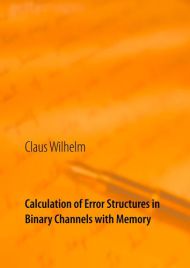Dr. Wilhelm, Claus: New models - symmetric binary channels with memory. BSC-M as an extension of the BSC Channel. Update February 2018, see ebook (pdf) google play and paper back (www.bod.de)
Welcome to the homepage of channels-networks. This website provides details of
results from my own research concerning disturbed binary channels and digital
networks, all of which are available for download.
First, a brief history of Channel Models - see downloads
In symmetric binary channels, bit errors occur in bundles.
Beginning in 1960 when E. N. Gilbert presented the first such model, today exists a
variety of model proposals which have arisen as a result of measured error
sequences.
The channel memory does not simply end with the last bit error, but rather extends
further into the past of the error bursts.
Thereby were the Hidden Markov Models (HMM) developed, which were then
perfected by William Turin.
What has however interested communication protocol developers and coding
theorists, are the probabilities of error structures in any finite time interval such as
the block length or the cycle length of a transmission procedure.
These probabilities are typically difficult to present analytically.
Many of my own studies, confirmed in the work of other authors, have found
that the block error probability (pb) dependent on the block length (n) in the initial part
is linear when presented double-logarithmically.
With this approach, the author C. Wilhelm developed the BSC-M as limit case of the BSC Channel (gap L-model and distance
A-model), with complete sets of formulae concerning the probabilities of error structures occurring in bursts, and in blocks.
So you can calculate analytically residual error probabilities occurring in codes and
transmission procedures.
In the same way, you can generate artificial error sequences.
One can vary the degree of bundling as well as the bit error rate.
The claim that HMM models are "accurate" speaks against the fact that the
Markov state space is constructed from finite measurements and is therefore no
more than statistically accurate.
After enough error-free steps, a "gap" is generated, which can be described as a
renewal process. This renewal process concludes with the occurrence of the next
error bit, whereby the HMM model begins over. For all of these gaps occurring
between bursts, the distance A-model should be applied, otherwise the Markov state
space will be too large.
Interestingly, short tests have shown that the distance A-model might function as a
time gap model when applied to sequences of motor vehicles. For example, the
probability that in n time intervals at least one car will pass by.
The basic formulas for the distance models are developed in
“Channel of Error Structures in Binary Channels with Memory”-see downloads
ass preview. The calculation of error probabilities for structures that are needed to evaluate
transmission procedures and codes is included in Part 2 of this book,
supplemented with calculation examples.
The content of this homepage was updated at least March 2018.
© channels-networks.net

